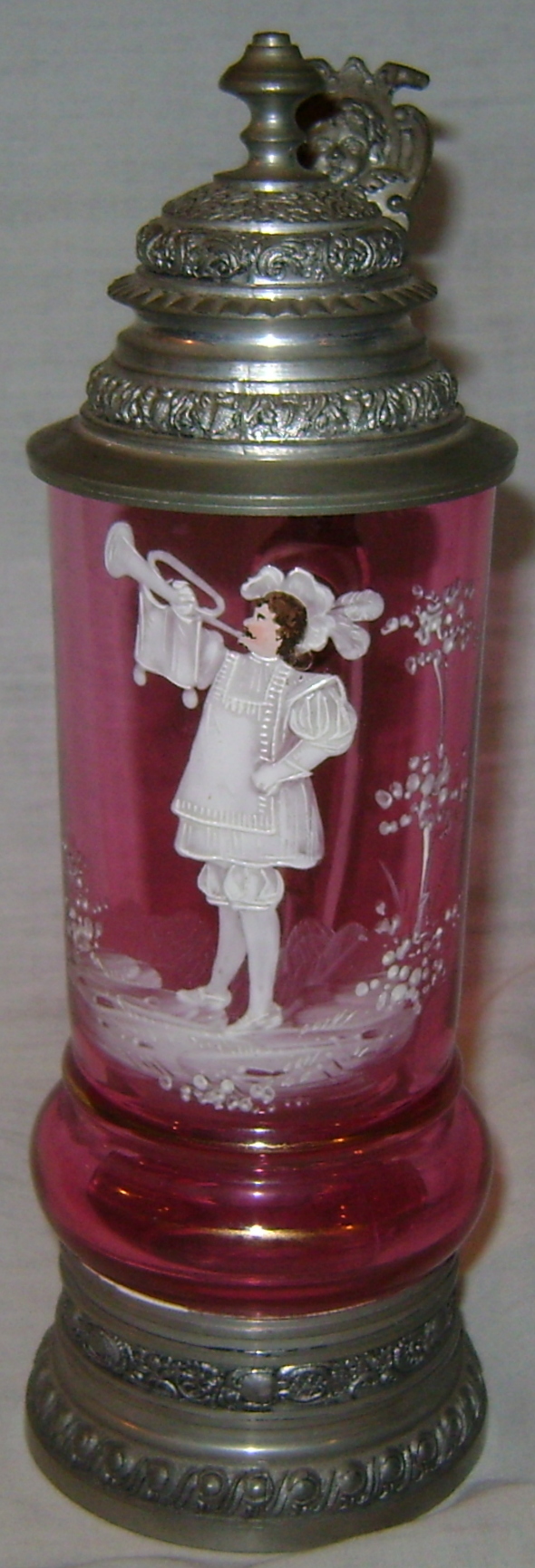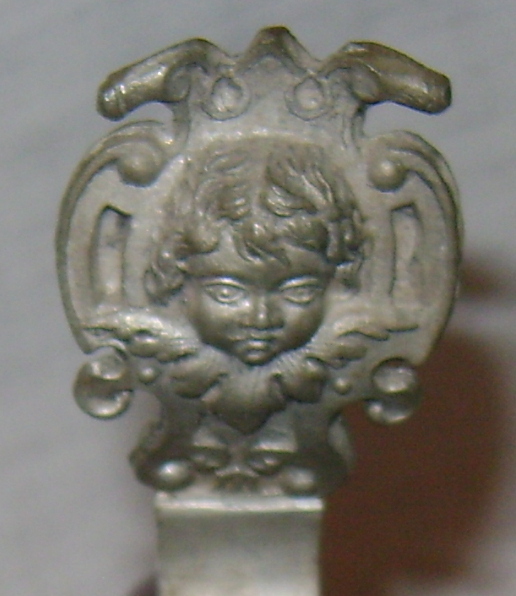 We purchased this stein from an antique dealer in Germany tweny-five years ago. It is referred to as a Mary Gregory. Mary Gregory is the name used for a type of glass that is easily identified. White figures were painted on clear or colored glass as the decoration. The figures chosen were usually children at play. The first glass known as Mary Gregory was made about 1870. Similar glass is made even today. The traditional story has been that the glass was made at the Boston & Sandwich Glass Company in Sandwich, Massachusetts, by a woman named Mary Gregory. Recent research says that none
were made at Sandwich. In fact, all early Mary Gregory glass was made in Bohemia.
(1)
We purchased this stein from an antique dealer in Germany tweny-five years ago. It is referred to as a Mary Gregory. Mary Gregory is the name used for a type of glass that is easily identified. White figures were painted on clear or colored glass as the decoration. The figures chosen were usually children at play. The first glass known as Mary Gregory was made about 1870. Similar glass is made even today. The traditional story has been that the glass was made at the Boston & Sandwich Glass Company in Sandwich, Massachusetts, by a woman named Mary Gregory. Recent research says that none
were made at Sandwich. In fact, all early Mary Gregory glass was made in Bohemia.
(1)
 Almost all of the Mary Gregory glass that we see in Europe was made at the Hahn Factory at Gablonz, which was in Bohemia but today is known as the Czech republic. Other factories in Bohemia also produced
Mary Gregory glass, even the highly regarded factory of Moser at Karlsbad.
(2) We have seen similar steins at Jack Pandl's restaurant in Whitefish Bay.
Almost all of the Mary Gregory glass that we see in Europe was made at the Hahn Factory at Gablonz, which was in Bohemia but today is known as the Czech republic. Other factories in Bohemia also produced
Mary Gregory glass, even the highly regarded factory of Moser at Karlsbad.
(2) We have seen similar steins at Jack Pandl's restaurant in Whitefish Bay.
We understand that reddish tint to the glass is different from the norm. The online Glass Encyclopedia offers a conflicting explanation on the origin, noting the "recipe" for red glass had been lost for centuries and then rediscovered in Bohemia during the 1600s. It goes on to say that Venetian glass crafters had tried to make red glass unsuccessfully for years.
Adding a bit of gold to a batch of molten glass in 1612, Italian glassmaker Antonio Neri discovered the secret required to produce "wondrous red glass that shimmered with the natural beauty of rubies," according information provided by a Cranberry Glass World article formerly published online. These types of contradictions often come into play in the world of collecting. Since we're looking back through centuries of information, researchers often have a hard time pinpointing exact dates and
 origins of some of today's most popular antiques. Regardless of the true origin of rediscovery,
there are a couple of facts everyone seems to agree upon. Cranberry glass does indeed use gold
chloride in its manufacturing process and the Romans made the famous Lycurgus cup of red glass,
cranberry's cousin, way back in the fourth century. The amount of gold chloride used intensifies
the red color, but it's basically the same process.
(3)
origins of some of today's most popular antiques. Regardless of the true origin of rediscovery,
there are a couple of facts everyone seems to agree upon. Cranberry glass does indeed use gold
chloride in its manufacturing process and the Romans made the famous Lycurgus cup of red glass,
cranberry's cousin, way back in the fourth century. The amount of gold chloride used intensifies
the red color, but it's basically the same process.
(3)
It is actually Marsha's stein. There were two steins to choose from, this one and Nazi stein. We couldn't afford both, she chose this one. Looking back it was the right decision.
(1) Kovels.com
(2) http://www.antiquecolouredglass.info
(3 )Looking Back in Cranberry Glass History “Collect a Crop of Cranberry Glass” by Pamela Wiggins, About.com Guide